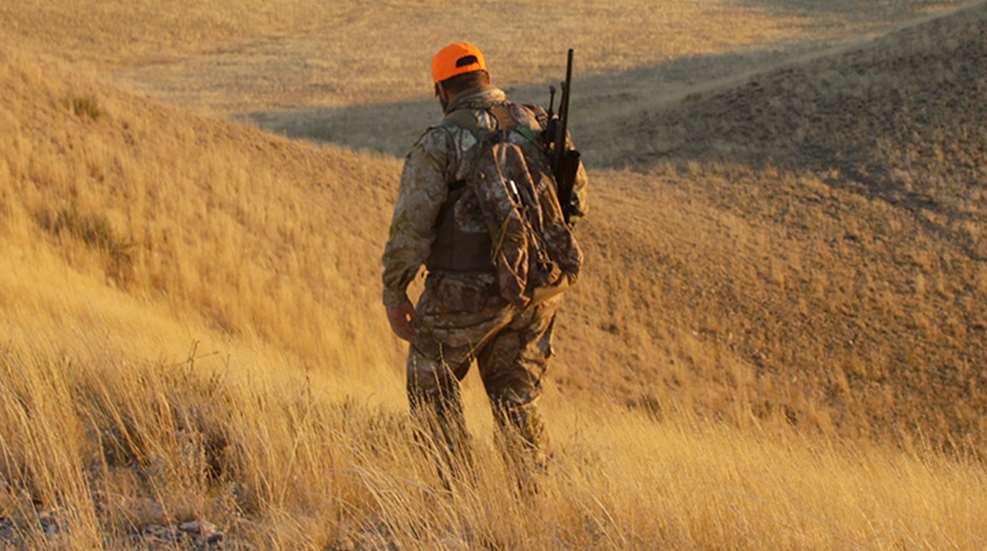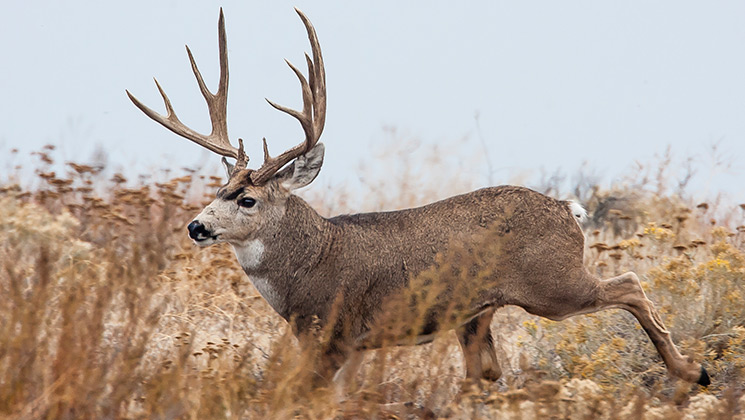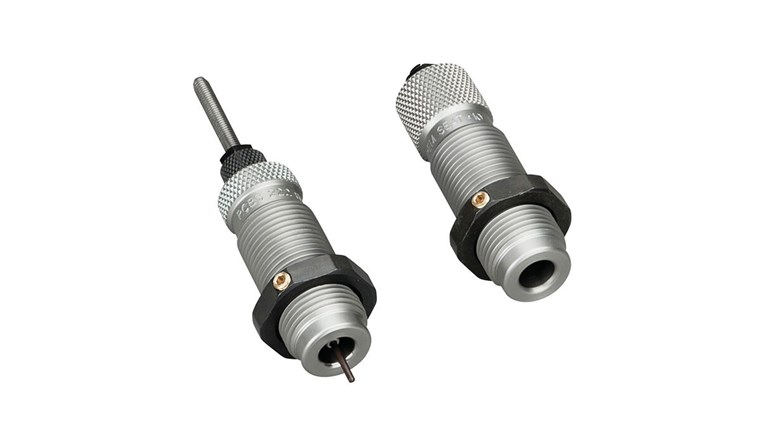
They say things happen for a reason, but at that moment I could not have cared less what they say as I watched the white rump of a mature mule deer buck evaporate into the dark vacuum of a juniper jungle. The buck had surprised me with his jack-in-the-box appearance from a shallow wash far away from obvious escape cover. It was like stepping on a hidden rooster pheasant. But unlike a rooster that takes to the heavens and gives a hunter ample time to swing a shotgun into action, the buck bounded twice and was swallowed by heavy boughs.
I was hiking to an overlook to catch bucks leaving the thick cover for evening browsing when the flush occurred. Should I have tried a snap shot? Why wasn’t I focused on the hunt? Why was the buck in such an odd hideout?
Regardless, the buck was pointed toward the boundary where my public-land hunt ended and his private-land refuge began. From scouting, I knew deer likely congregated on the private side of the fence, where hayfields still offered a buffet. Those fields were off limits, but with the buck headed in that direction and cover dissipating like clouds after a thunderstorm, I figured I might just get a last-minute meeting with him. So I cinched down my pack tight and started jogging to a likely intercept point.
Most deer hunters understand the cagey nature of whitetails, how the species can adapt to nearly any environment in North America. But mule deer don’t seem to possess the same environmental flexibility. Still, it’s important to note that on their side of the Mississippi River, mule deer inhabit more than just a Rocky Mountain landscape. There, timber offers them escape, but they can dwell in the open, too. Don’t overlook either, especially if the two adjoin. Mule deer can be just as comfortable in the woods as they are in the plains.
Maybe the reason mule deer don’t hold favorite homelands is due to the fact that whitetails and mule deer are nearly identical in the DNA department. Renowned professor Dr. Valerius Geist explains in the book Mule Deer Country that mule deer are descendants of white-tailed deer, the oldest deer species in the Western Hemisphere. Arriving on the scene nearly 4 million years ago, white-tailed deer spread throughout North America, Geist notes, finally populating the Northwest coast. In this environment, they evolved into the black-tailed deer. Approximately 10,000 years ago major changes spread across the continent including the defining extinction of many varieties of herbivores and carnivores. Geist believes this allowed both white-tailed and black-tailed deer to expand populations and range. The two species spread toward the center of the continent where inevitably the species mingled, resulting in the newest species: mule deer. The newcomer filled niches, open and timbered, west of the Mississippi.
Whitetail Mind-Set in the Rocky Mountains
The mini-mountains of South Dakota’s Black Hills were my first introduction to forest-dwelling muleys. As a young hunter, running into mountain mule deer in the ponderosa pines was as common as seeing white-sock-wearing tourists at nearby Mt. Rushmore. Whitetails also called the Black Hills home. Both species gravitated toward openings for browsing opportunities, but neither shunned a pine-canopy sanctuary.
Mule deer inhabit the highest peaks, 12,000 feet or more, until snow forces them lower. They find solace in forested foothills and they have no aversion to joining whitetails on cottonwood river bottoms of the West. Hunting them in such a diverse timberland environment squashes some traditional tactics, but opens up more creative possibilities.
You won’t be able to spot-and-stalk as effectively as in an open environment, but take along your binocular and spotting scope anyway. Instead of looking across canyons, you’ll scan edges for feeding activity at dawn and dusk. Focus on high, alpine bowls, hidden parks and any water sources coursing downhill. Also seek out recently logged areas or old burns. Browse species thrive in these environments, not in the shaded shelter of thick pine boughs and needle-covered soil. Two exceptions to this rule are inside stands of stately aspens and the interior of Gambel, also known as scrub oak, where shade and browse intermix. Give such habitat your undivided attention. More than one giant buck has been spotted entering or leaving such a high-country hideout.
On a past Colorado hunt my guide and I focused on a canyon choked with scrub oak that abutted endless forest. Small openings on the canyon floor provided added nutrition for the local deer herd. We spotted a possible candidate just after sunrise, but he didn’t stay in the open long and soon slipped into impenetrable oak brush. After a long day of peering into side canyons we returned and took up watch for his arrival at dusk. At sunset I stood, stretched and peaked into a bowl above me. To my surprise the target buck was following a doe and only steps from an escape into forest. He had used the oak as a veil to circle around us! I dropped prone and sent a Hornady SST 300 yards to halt his escape.
If openings don’t deliver, take the hunt into the forest. Be your own judge, but consider forest still-hunting as a midday strategy. Some habitats may be too thick for this approach, but if you can see 75 yards or farther you may have a chance. Put the wind in your face and move through these environments at the slow pace of Congress. Glass ahead every few steps for flicking ears, glistening noses and twitching tails.
This tactic also shines in river corridors, especially if you can hunt the rut like Montana’s November season. Bucks often drop out of higher elevations to flee snow and look for does collecting on valley hayfields. Still-hunt through thick-timbered bottoms looking for buck activity. Growing up in the crossover world of the Great Plains, I routinely called mule deer into setups. Today I utilize still-hunting and calls equally on either species.
Open-Country Combing
Open country also varies like the Western forests. It includes the deserts of the Southwest all the way to wheat fields of the Great Plains. Mule deer thrive throughout it all. This country is made for spot-and-stalk. Enter it with quality optics and flat-shooting calibers (or arrows).
Breaking down open country poses a real hurdle to success. Don’t be naive. You may see from horizon to horizon, but in between exists a host of food sources and untold folds of terrain to hide deer. Despite a mule deer’s inclination to eyeball danger, mature bucks shun this custom to disappear in virtual nothingness.
Consider food first. In desert and sagebrush environments mule deer may only have native browse for sustenance. It’s everywhere, but survey lowlands first. River valleys, creek bottoms and arroyo washes all receive surplus moisture due to runoff, and even from trickling springs. This creates a moist environment for browse to thrive. Another bonus: Some ranchers have developed these bottoms for agricultural benefits, including hay. Watch for deer coming and going to profit from this productivity.
Of course in some arid regions water is a precious commodity. In remote areas bucks may water during daylight, but others often drink nocturnally. Trail cameras can help you determine which kind you’re hunting. Even if deer avoid a drink during daylight, mark water options and look for bedding options and feed anywhere from 1 to 3 miles out; deer will be somewhere in between.
As the prairies green farther to the east mule deer invade croplands with regularity. Winter wheat, sorghum and even irrigated corn attract attention. This is where a full understanding of the surrounding geography plays into overall success. Hunting pressure and harvest may force you to watch adjoining rough country since bucks could leave a succulent food source well before shooting light.
This happened to me in eastern Colorado during an October muzzleloader hunt. Mule deer were not ignorant to the upland buffet of sorghum and other crops, but they knew if they didn’t make it back to rough country by daybreak they’d be as exposed as a famous politician in Weinergate.
It took several days of losing the race to put a plan in place. We had to start the hunt in the rough country, not at the field edge. When the deer passed in the dawn glow, they were much easier to track as they slipped to a series of eroded gullies for daytime cud chewing. Moving downwind and stalking with a hunched back in the bottom of a dry creek bed paved the way to a muzzleloader-close shot. A detour around an irritated rattler slowed the pace slightly, but soon my CVA muzzleloader was ready for smoke when the bucks stood. They finally stretched, and I aimed at the biggest. It was history-making smoke for me with a giant, both in body and antler dimensions.
Mule deer have no aversion to hiding in fence lines, crawling into shallow coulees and even bedding on open hillsides if big views offer the only security available. I’ve watched them take to standing corn like a whitetail for cover, and more than once I’ve been shocked as bucks bolted out of old barns while I passed long-forgotten homesteads. Nothing is off limits in the flatlands.

Boundary Bounty
You need to be on your A game when worlds collide. Regions of mule deer country often contain vast open spaces squarely adjacent to a forest maze. You really can’t predict which one deer might prefer. While hunting the prairies of eastern Montana next to pine-covered mountains, easily within walking distance of feeding fields, I’ve noticed bucks routinely stop short of the assured refuge. On other occasions I followed along as deer left lowlands and I eventually gave up the chase as they marched to distant, pine-covered bluffs miles away.
This randomness means you have to be ready for mule deer to spend time in the wide-open one day and timber the next. Think like a whitetail hunter and work edges. This pays dividends in Western real estate where public and private lands meet, generally in an edge setting. It’s common for lush bottoms to be under private deed and the upper forests under public domain. Survey the edges of public timber with a view toward lower openings or sprawling, private fields. GPS programs like HuntXMaps (huntinggpsmaps.com) are invaluable in these bottlenecks.
Deer may race to timber or shortstop in between. Depending on boundaries, you may be in place to waylay a buck with a timber tendency or you may see deer lingering in the field-to-forest transition area. If you get the GPS green light, plan a stalk.
Whatever you do, do it speedily. Randomness is an evolutionary characteristic that extends past habitat preference. If you bust a buck and it senses a trap, you may never see it again. Mature mule deer bucks can be just as slippery as a whitetail. One year I was hunting with a good friend in Montana and we watched a trophy-class buck on a hayfield two days in a row. We put a plan together and my friend missed a shot at 250 yards. It was the last time we saw that buck. Even the local outfitter didn’t have any luck tagging it.
Did that buck hire a moving company or simply become craftier? Bill de Vergie, a 25-year veteran of Colorado Parks and Wildlife, serves as the area wildlife manager for the entire northwest quadrant of his state. He offers another factor to consider for a buck’s disappearance. Regarding elk, de Vergie absolutely knows hunting pressure causes them to move, but 30 years of data and new GPS studies confirm mule deer stick close to home until a specific date. When that calendar date arrives they make their autumn move to more hospitable habitat for winter with atomic-clock-like precision.
“Mule deer are hard-wired to move almost the same day, every year. The minute, whatever it is, decreasing daylight or another factor triggers them, they move,” notes de Vergie. “It’s nearly the same day year after year. They are very repetitive in the process and it doesn’t matter if we are in the middle of a drought or facing 2 feet of snow. They begin to travel.”
De Vergie says wardens talked about this phenomenon for years, and now transmitter studies confirm it. He doesn’t argue that hunting pressure on deer may cause major movement in certain areas, but in northwest Colorado, major mule deer movement is a scheduled event.
My lungs ached as I reached a canyon that bordered the private-land fence. At this point, the juniper jungle was broken down into scattered clumps. I could already see the rumps of deer across the expanse browsing on the hayed, private pasture. A quick scan with my Nikon revealed the rooster buck wasn’t amongst them. I belly-crawled to peer farther into the canyon depths below. Big ears and white rumps appeared—it was a group of does staging to be next in line for the hayfield bonanza.
Easing up even higher on my elbows, I spied antlers. It was the rooster buck! Slipping off my pack to minimize my prone height, I nudged ahead for a bipod-steady shot. I dialed up the power on my riflescope to boost my confidence and accurately align my reticle, and I tried to control my breathing, which was heavy due to my jog—and because of buck fever.
Confident with the crosshairs, I depressed the trigger. The Hornady SST buckled the framework of the buck and he lunged. I could hardly believe what had just transpired: A bungled meeting transformed into a sure thing in the open-and-closed world of the mule deer. They were right: Things do happen for a reason.




































